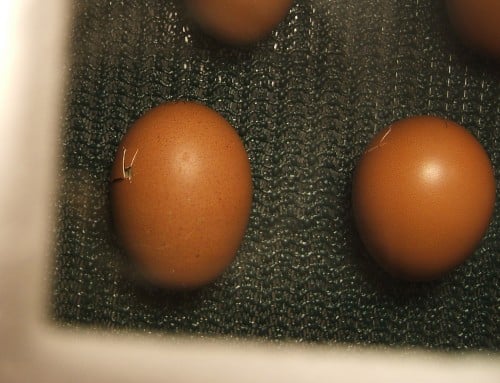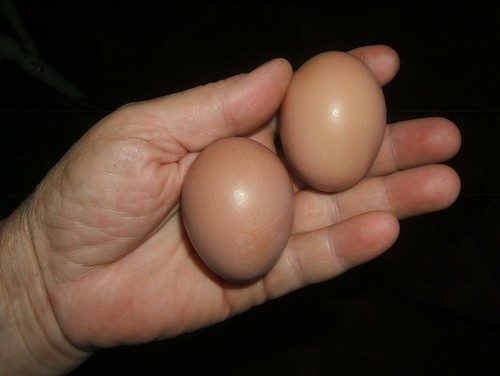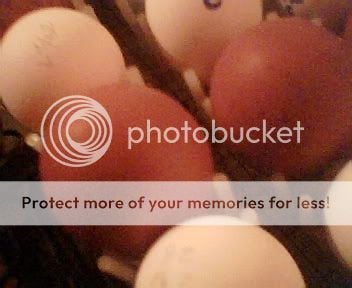I'm looking for some of the chocolate egg layers (LOL, that sounds funny!) and I'm wondering if Cuckoo marans lay the really dark eggs. Also, what's the difference between the Cuckoo and french marans??? Other than the coloring and feathered legs??? And the price? LOL! Is anyone selling Cuckoo maran eggs for hatching??? How much??? Thanks, guys!!!
Navigation
Install the app
How to install the app on iOS
Follow along with the video below to see how to install our site as a web app on your home screen.
Note: This feature may not be available in some browsers.
More options
You are using an out of date browser. It may not display this or other websites correctly.
You should upgrade or use an alternative browser.
You should upgrade or use an alternative browser.
Cuckoo Marans....do they lay really dark eggs???
- Thread starter cjeanean
- Start date
More options
Who Replied?They lay dark dark eggs, but it also depends on where you get them from. There may be some sources where the birds you get are not as pure and may not lay the dark dark eggs. I think the cuckoo and french may be 2 dif colors but dont take that to the bank. I think they would cost about the same as any other chicken


- Jan 25, 2008
- 3,832
- 41
- 221
They lay dark eggs if you get them from good breeders. Most breeders will brag about their color rating and show pics and the whole nine yards. There are a couple threads about the Marans already, one of the most recent showing several Marans Clubs. Do your research on the breeder and you'll be okay.
Also, the color of the eggs lighten as the season goes on. So don't expect those best colors to be laid all season long.
-Kim
Also, the color of the eggs lighten as the season goes on. So don't expect those best colors to be laid all season long.
-Kim
Cuckoo is a color variety within the breed (there are also copper blacks, wheatens, whites, and several others....). The breed is a breed that originated from France. The French standard calls for, among other things, feathered shanks. There is no such thing as a "French Marans" in terms of variety or color, etc.. It's somehow developed into some sort of mystical variety...
 When breeders started working with the breed here in the U.S., the gene pool became very limited (it's very hard and very expensive to get eggs from overseas) and so in some cases the breed was crossed with other like breeds (e.g., barred rocks) to keep it going. Two different "versions" developed, the main distinguishing features between the two being clean legged and feather legged. The clean legged are sometimes referred to as being the "American" type and the feather-shanked, the "French" type. I believe that there have been attempts to standardize both types as separate varieties within the variety--or at least, to make both types acceptable within a standard (of course, at this point, the breed is not recognized at all by the APA and there is no official standard here in the U.S. yet).
When breeders started working with the breed here in the U.S., the gene pool became very limited (it's very hard and very expensive to get eggs from overseas) and so in some cases the breed was crossed with other like breeds (e.g., barred rocks) to keep it going. Two different "versions" developed, the main distinguishing features between the two being clean legged and feather legged. The clean legged are sometimes referred to as being the "American" type and the feather-shanked, the "French" type. I believe that there have been attempts to standardize both types as separate varieties within the variety--or at least, to make both types acceptable within a standard (of course, at this point, the breed is not recognized at all by the APA and there is no official standard here in the U.S. yet).
So anyway, long story short, someone saying that they have "French Marans" might mean that they are breeding for the French standard (i.e., feather-shanked instead of clean-legged) within the variety (which could be Cuckoo, Copper Black, etc.). Or, they might have some Marans with feathered legs and think that means they have "French Marans" and that that makes them superior birds. Really, quality egg color is the only thing that's going to tell you if you have quality birds or not, and the bird having feathers on its legs isn't going to make it lay a darker egg. Me personally, I like the feathered legs and, being a French breed, I want to breed my birds to meet the French standard as best I can. So I try to breed for feathered shanks, but there are a lot of good genetics (with regard to dark egg color) from Cuckoo breeders who have both feathered and clean-legged birds in their flocks. So I do have a few birds with clean legs. But I have to look at egg color first, and then type. I'm hoping, in a couple of years, to have a flock that breeds true (most of the time) for feathered shanks.
Egg color is super tricky, and the genetics are not very well understood. Egg color can vary widely from line to line, breeder to breeder, bird to bird within the same flock, and even from the same bird over the course of their laying cycle (like Kim pointed out, the color does lighten up as the bird's laying cycle progresses). Don't expect to get hatchery birds and get great egg color. You might get darker-than-usual eggs, but not by much (in most cases). And just be aware that, even in well-bred birds, the egg color is not going to be consistent. Also, different varieties lay darker eggs than others. Copper Blacks seem to have the best egg color going here in the U.S. (of course, this means they are also the most pricey!
 ). I think that some lines of Wheatens have good dark egg color, too. Cuckoos are the most widespread and easily available variety--this also means that there is a wide variance in quality of egg color. In general, they do not lay as dark an egg as the Black Coppers. However, I think that in a well-bred line of Cuckoos you can get good egg color somewhat consistently.
). I think that some lines of Wheatens have good dark egg color, too. Cuckoos are the most widespread and easily available variety--this also means that there is a wide variance in quality of egg color. In general, they do not lay as dark an egg as the Black Coppers. However, I think that in a well-bred line of Cuckoos you can get good egg color somewhat consistently.
I think I posted in that thread Kim was talking about....if I can find it again I'll post you the link here. There was some good info there. And some pictures of eggs.
Here it is! It was only a few posts down...
 https://www.backyardchickens.com/forum/viewtopic.php?id=69737
https://www.backyardchickens.com/forum/viewtopic.php?id=69737

So anyway, long story short, someone saying that they have "French Marans" might mean that they are breeding for the French standard (i.e., feather-shanked instead of clean-legged) within the variety (which could be Cuckoo, Copper Black, etc.). Or, they might have some Marans with feathered legs and think that means they have "French Marans" and that that makes them superior birds. Really, quality egg color is the only thing that's going to tell you if you have quality birds or not, and the bird having feathers on its legs isn't going to make it lay a darker egg. Me personally, I like the feathered legs and, being a French breed, I want to breed my birds to meet the French standard as best I can. So I try to breed for feathered shanks, but there are a lot of good genetics (with regard to dark egg color) from Cuckoo breeders who have both feathered and clean-legged birds in their flocks. So I do have a few birds with clean legs. But I have to look at egg color first, and then type. I'm hoping, in a couple of years, to have a flock that breeds true (most of the time) for feathered shanks.
Egg color is super tricky, and the genetics are not very well understood. Egg color can vary widely from line to line, breeder to breeder, bird to bird within the same flock, and even from the same bird over the course of their laying cycle (like Kim pointed out, the color does lighten up as the bird's laying cycle progresses). Don't expect to get hatchery birds and get great egg color. You might get darker-than-usual eggs, but not by much (in most cases). And just be aware that, even in well-bred birds, the egg color is not going to be consistent. Also, different varieties lay darker eggs than others. Copper Blacks seem to have the best egg color going here in the U.S. (of course, this means they are also the most pricey!

I think I posted in that thread Kim was talking about....if I can find it again I'll post you the link here. There was some good info there. And some pictures of eggs.
Here it is! It was only a few posts down...

Last edited:
Hatchery marans will lay you a darker than normal egg but you won't get the deep dark coloring like from a breeders marans.
Here are some cuckoo marans eggs pipped that I bought to hatch this spring. They are not really dark, but compare them to the red star pullet eggs in the next photo. On my computer the colors are fairly accurate.




Good job Crunchie, not much left to say. Just do your homework,read up on the breed and know what your purpose is. If you are thinking of selling eggs or birds,remember establishing your own line is a slow process and you will have to invest money in birds from good breeders and you will have to select birds that are as close to the standard as you can get. If you just want dark eggs for your own use,you don't have to be so picky.
here is a pic of some of my eggs(the darker ones in the pic)

here is a pic of some of my eggs(the darker ones in the pic)

Last edited:
I am informed now
 Crunchy nice job!
Crunchy nice job!

"mystical breed
 " ye
" ye




"mystical breed



Informed, or just bored??
 I just looked at that post again and thought, "man are you long-winded!" My fingers type faster than my brain, I get a bit, um, carried away sometimes.
I just looked at that post again and thought, "man are you long-winded!" My fingers type faster than my brain, I get a bit, um, carried away sometimes.

OK, well, just to add to any confusion and muddy the waters a bit more, I just learned something new today about the origins of the Marans here in the U.S. In case anyone is as obsessed over detail as I am.
 Apparantly most of the Marans here in the U.S. came from France by way of England. The breed had taken a hard hit in numbers and had mostly already lost the feather-shanked trait--feathered shanks is a trait that we (and the Brits) have been breeding back in ever since, I suppose in an attempt to bring the birds back to the French standard.
Apparantly most of the Marans here in the U.S. came from France by way of England. The breed had taken a hard hit in numbers and had mostly already lost the feather-shanked trait--feathered shanks is a trait that we (and the Brits) have been breeding back in ever since, I suppose in an attempt to bring the birds back to the French standard.
I'm really not too informed on the history and the origins of the breed, but I did pick up this little tidbit of info up today and found it interesting. Makes the "French" Marans all the more mystical.

I agree with Gina that it takes time to establish your own flock of Marans. I've had these birds for a couple of years, but I still don't consider them "mine". I have passed along a few eggs here and there, and I'll do so again in the near future (if my broody girls cooperate!
 ), but they aren't "my" line. I have to give props to the breeders that I got my stock from, they put a lot of time, effort and money into those birds. I think maybe in another year or two I might have a group of birds that I can call my own.
), but they aren't "my" line. I have to give props to the breeders that I got my stock from, they put a lot of time, effort and money into those birds. I think maybe in another year or two I might have a group of birds that I can call my own.



OK, well, just to add to any confusion and muddy the waters a bit more, I just learned something new today about the origins of the Marans here in the U.S. In case anyone is as obsessed over detail as I am.

I'm really not too informed on the history and the origins of the breed, but I did pick up this little tidbit of info up today and found it interesting. Makes the "French" Marans all the more mystical.

I agree with Gina that it takes time to establish your own flock of Marans. I've had these birds for a couple of years, but I still don't consider them "mine". I have passed along a few eggs here and there, and I'll do so again in the near future (if my broody girls cooperate!


New posts New threads Active threads
-
Latest threads
-
Backyard Chickens near Lake Murray, SC - Newberry or Lexington Counties
- Started by Justicedog
- Replies: 0
-
-
-
-
Whats are these, i have no idea!
- Started by Mel35
- Replies: 4
-
-
Threads with more replies in the last 15 days
-
-
-
-
Please Help! Eggbound & Possible Prolapsed Vent
- Started by Elspeth Dinsmore
- Replies: 103
-
Can I get some help from someone with careless neighbours who own dogs.
- Started by RiDaGeckoGuy
- Replies: 102
-
